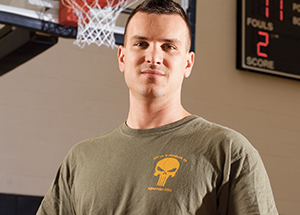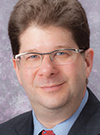Rebuilding Muscle, Strengthening Lives
Sergeant Ronald Strang survived an IED blast in Afghanistan that shredded muscle from his left leg. After 18 months and 14 surgeries, his movement was still very limited. So he entered a Pitt-UPMC study that would test a new approach to significant muscle loss. Researchers began with some physical tests. For instance, Strang was asked to jump as far as possible while standing on his left leg, where his quadriceps had lost 68 percent of muscle tissue. The best he could do was hop about an inch.
 Then, Strang underwent a groundbreaking surgery that used tissue scaffolding created from a pig’s bladder to spur new muscle growth. Six months later, he was asked to jump again, using only his wounded left leg. This time, he was able to leap 24 inches.
Then, Strang underwent a groundbreaking surgery that used tissue scaffolding created from a pig’s bladder to spur new muscle growth. Six months later, he was asked to jump again, using only his wounded left leg. This time, he was able to leap 24 inches.
Strang was one of five men who took part in this study, supported with funds from the U.S. Department of Defense and conducted by the McGowan Institute for Regenerative Medicine, a Pitt and UPMC program. Stephen Badylak, deputy director of the McGowan Institute, and J. Peter Rubin, chair of the Department of Plastic Surgery, led a team of researchers on the study. The results were published in 2014 in Science Translational Medicine.
For the study, the researchers used an extracellular matrix (ECM) from a pig’s bladder to regenerate diminished skeletal muscle. An ECM is the tissue that remains after all cells from the tissue have been removed. Badylak, a professor of surgery in Pitt’s School of Medicine, has been researching the effects of ECM since 1987. He began by using tissue that contained cells but soon discovered that it was the cell-less ECMs that promoted recovery. It appears that the removal of cells limits complications such as the rejection of foreign cells as well as the development of infection.
 This was the first study ever to regenerate muscle in humans by applying ECMs, although researchers have previously used ECMs to repair urinary bladders, hernias, and esophageal lining. The scientific principles are the same, no matter the body part, Badylak explains. These cell-free scaffolds look like a translucent sheet. When placed in a patient’s body, they recruit the patient’s own stem cells and alter the function of “inflammatory” cells so that they all aid in the regeneration of healthy tissue, he says.
This was the first study ever to regenerate muscle in humans by applying ECMs, although researchers have previously used ECMs to repair urinary bladders, hernias, and esophageal lining. The scientific principles are the same, no matter the body part, Badylak explains. These cell-free scaffolds look like a translucent sheet. When placed in a patient’s body, they recruit the patient’s own stem cells and alter the function of “inflammatory” cells so that they all aid in the regeneration of healthy tissue, he says.
In each of the study’s five surgeries, scar tissue from the damaged leg muscles was removed, and the ECMs were placed next to nearby healthy muscle. Within months, mature skeletal muscle cells emerged at the site of the ECM placement, along with other cells that appeared to be actively regenerating into skeletal muscle cells. The ECMs, meanwhile, did their job and eventually dissolved altogether, leaving only healthy muscle.
 Three of the patients showed 20 percent or greater improvement in strength of the injured leg. One patient increased his single leg jump from 3 to 35 inches. And the results didn’t only show dramatic improvement on physical tests. Strang and the other participants are now engaging in a range of activities including running, bicycling, playing soccer, and even skiing—exercises they couldn’t have enjoyed before their surgery.
Three of the patients showed 20 percent or greater improvement in strength of the injured leg. One patient increased his single leg jump from 3 to 35 inches. And the results didn’t only show dramatic improvement on physical tests. Strang and the other participants are now engaging in a range of activities including running, bicycling, playing soccer, and even skiing—exercises they couldn’t have enjoyed before their surgery.
“We love science, and we’re very interested in these stem cells,” Badylak says. “But at the end of the day the story is incomplete without the impact on patients’ daily activities.”
Over the years, he has gained more insight into exactly how the cell recruitment occurs. “It’s like putting together a puzzle where you never know how many pieces there are,” he says. With questions remaining, the team, which consists of researchers from multiple medical disciplines, will continue to study the phenomenon.
Since the initial research was completed, 10 more patients have entered the study, applying the same treatment to help those with volumetric loss of muscle tissue.
“We’ve really leveraged the incredible research environment at Pitt,” says Rubin, the lead surgeon on the trial and the UPMC Endowed Professor of Plastic Surgery. “This work brings together very talented people with complementary skillsets who can help improve the lives of our patients—especially our wounded warriors.” (Courtesy of Pitt Magazine.)
Other Stories From This Issue
On the Freedom Road

Follow a group of Pitt students on the Returning to the Roots of Civil Rights bus tour, a nine-day, 2,300-mile journey crisscrossing five states.
Day 1: The Awakening
Day 2: Deep Impressions
Day 3: Music, Montgomery, and More
Day 4: Looking Back, Looking Forward
Day 5: Learning to Remember
Day 6: The Mountaintop
Day 7: Slavery and Beyond
Day 8: Lessons to Bring Home
Day 9: Final Lessons

